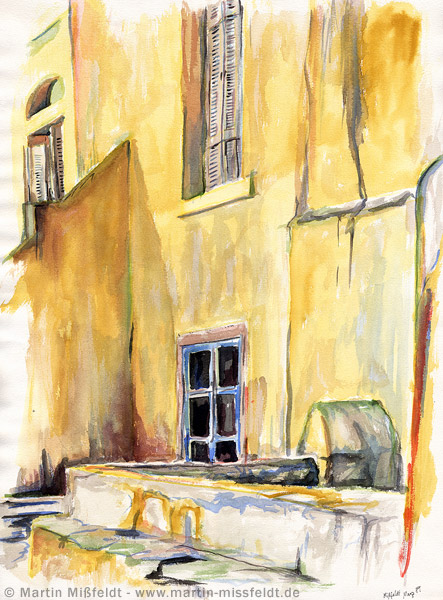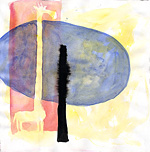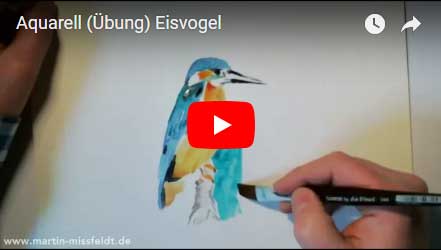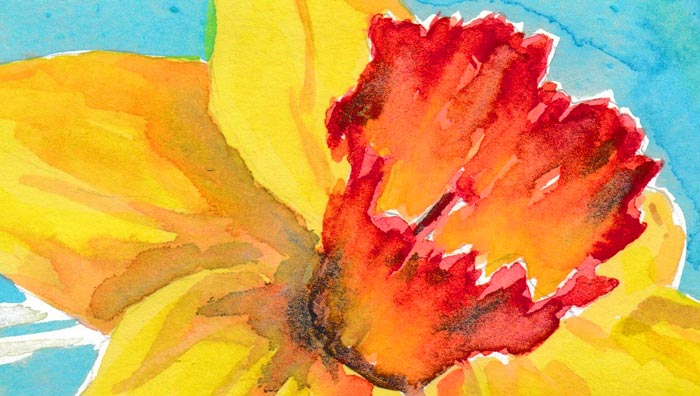
Watercolor painting
On this page three sections on the subject of "Watercolor" are presented. First, a small introduction to watercolor painting shows the possibilities offered by watercolor. Second, different watercolor painting techniques are introduced. They show, how the motive can be emphasized by the purposeful employment of the watercolor technique. Thirdly, I present exemplary some watercolor pictures and paintings of me in the text.
An online-tutorial "How to paint a watercolor" is impossible - or let's say: senselesse. Watercolor painting simply offers too many forms of expression. A restriction regarding a "correct" use of watercolor would be wrong.
In this article different perspectives on watercolor painting are presented. This should inspire and motivate you to try and simply paint with watercolor.
History of watercolor painting

Watercolor abstract landscape
Watercolor painting has one big advantage: it quickly leads to final pictures. In contrast to many other artistic techniques, the "starting effort" is low. In addition, the drying process is very short. That's why many painters used watercolors for sketches and studies. A select group of artists who have shaped the history of watercolor painting:
- Albrecht Dürer (1471 - 1528) was one of the first to use the watercolor painting for his own purposes. His watercolors "Das große Rasenstück" and "Der Feldhase" are masterpieces of watercolor art. They are, however, partly painted with white, so that Dürer should rather speak of mixed technique or gouache in the strict sense.
- William Turner (1775 - 1851) was an outstanding artist in the history of watercolor painting. His watercolors "Vierwaldstätter See" and "Brennendes Schiff" show impressively how Turner was able to use the watercolor technique for the atmospheric mood.
- Eugène Delacroix (1798-1863) recognised the intense light atmosphere of the Mediterranean sun on a trip to Marroko. The bright colours and hard contrasts can be reproduced well with the help of the watercolor technique. His watercolors "Moroccan courtyard" and "Bay of Tangier in Morocco" are good examples of this.
- Winslow Homer (1836 - 1910) was an "early" American painter. He painted watercolor paintings with atmospheric views of the sea and the weather. Examples are the watercolors "After the Tornado" and "Sailing the catboat".
- Carl Larsson (1853-1919) is one of the most famous Swedish painters. He used the watercolor technique in combination with hard contours for incredibly harmonious, idyllic family pictures. His watercolor paintings "The Fishing" and "Breakfast under the Big Birch" shaped the picture of the middle-class Swede.
- August Macke (1887-1914) brought the brilliance of watercolors to a climax. During a journey through North Africa (Tunisia) he also used watercolor to capture the intense colour and light atmosphere. Good examples are his watercolor paintings "Kairouan (III)" and "Landscape near Hammamet".
- Emil Nolde (1867-1956) has considerably advanced the development of watercolor painting. His watercolors such as "The Rough Sea" and "Tulips and the Watery Heart" also had a great influence on contemporary watercolor painting.
Of course, these are only very few examples from art history. But they show how versatile the watercolor technique is.
Watercolor - Features and characteristics

Light: very important for watercolor paintings
Like all colours, watercolor paints consist of colour pigments and binding agents. The binding agent used for watercolor paints is usually gum arabic. It is water-soluble and practically transparent. In contrast to gouache, no diluent is added to watercolor paint. The colour is therefore practically "pure". Therefore, watercolors can have a tremendous luminosity and color purity. It is not without reason that many watercolor paintings convey a sunny, light-flooded atmosphere.
An essential difference to all other painting techniques is that there is no colour "white". White or light coloured surfaces are created by omitting the colour. White is created by "omitting". Not to paint a colour, but to let it develop through omission, is also called negative technique. This rethinking requires planning and some practice.
More about the peculiarity of watercolor paint.
Water has a special meaning in watercolor painting. The essential technical characteristics of watercolor painting are due to the special use of water. Watercolor painting could also be described as "water painting with mixed colours". However, the solvent for the watercolor does not necessarily have to be "only" water. One can, for example, experiment with soaps, whereby the paint dries more slowly. Bubbles can form interesting structures. Also pure alcohol is suitable as solvent (also together with water). In contrast to water, it is much more volatile. Thus the watercolor paints dry faster, partly seconds after the application of the paint. In this way, much "harder" structures can be produced.
Aquarell painting skills - Glazing and Washing (lavering)
Watercolor painting is actually "water painting". Two special painting techniques bring out the watercolor particularly well: glazing and washing-up. Both techniques work with the properties of water. On the one hand, it takes some time to dry. This gives you about one to three minutes to paint wet-in-wet (lavering). On the other hand, it dries so quickly that you can paint over the already dried layers of paint (glazing). As a rule, both methods are used for watercolor painting.
Glazing

Watercolor glazing
Fast drying of the water plays a role in glazing. The term glazing refers to the application of paint in which the underlying layer of paint or the background remains visible. The watercolor gets a special radiance (colour fastness) when it is applied semi-transparently to the white background. By superimposing several layers of colour on top of each other, light-dark gradations or mixed colour values are created. Due to the volatility of the water, the watercolor paint dries relatively quickly. After only a short time, new "watercolor glazes" can be applied to the underlying surfaces. It is important that the underlying layers are well dried. In addition, the glaze should be painted quickly. Otherwise the lower layer of paint could dissolve. The controlled layering of coloured surfaces is an essential feature of watercolor paintings.
Washing (lavering)

Watercolor washing (lavering)
Washing, on the other hand, is based on the property that the watercolor diluted with water remains liquid or moist for some time. During this time it is possible to paint into this surface with a different colour. This process is also called wet-in-wet painting. Thereby the colours melt and blur. Basically not the colours melt, but the water, which carries the colours in itself. It tries to distribute itself as evenly as possible. Surfaces with more liquid flow in the direction of the more dried surfaces. However, the water does not cross the "wet line". It only melts in the area that was previously wetted by the brush. The result is colour structures and colour areas in which the different (or the same) watercolors "melt". The process of washing can be influenced by various "aids". For example, by using a "straw" or a puster tube, the color can be pressed in a certain direction. This is also possible with wide fan brushes. The best known wet-on-wet watercolorist is Emil Nolde.
In addition to washing with several colours, only one colour can run from transparent to opaque. This technique ("gradient technique") is quite difficult. The difficulty lies in the fact that the watercolor does not run evenly, but usually collects in small "pools of water". It is helpful to first delimit the surface with pure water and then apply the watercolor on one side and pull it to the other side with the fan brush. With a paper towel ("kitchen roll") the watercolor can be "sucked off" at one edge.
Which brushes for watercolor painting?
Red marten brushes are very suitable as brushes for watercolor painting. They can absorb a lot of water (and watercolor). In addition, they are particularly dimensionally stable and retain an unfringed brush tip for a long time. And they release the color very controlled and evenly again. For my watercolors I use Kolinski Red Marten Brushes as well as brushes with synthetic hair. Brush thicknesses range from 0 to 24. A sponge and absorbent paper towels are also part of the tools of the trade. But there is no reason why you shouldn't paint with your fingers from time to time. Further down you will find more painting tools and aids. More about watercolor brushes.
Which paper is suitable for watercolor painting?
As already explained, watercolor painting is based on water. This can only unfold its full strength if it "works properly" on the medium. Usually watercolors are painted on paper. It has a substantial influence on the result. Conventional papers (80 - 100 gr/qm) have the disadvantage that they become wavy. In addition, their surface is smoothed, so that the watercolor is only slightly absorbed. The sheet will then already have little water on it. A laid paper of 200 to 600 gr/qm is best suited for watercolor painting. Heavy papers and handmade laid paper often have the disadvantage that the watercolor runs into the furrows of the paper fibres. This often makes the edges of these watercolor pictures appear "frayed". Which paper is used also depends on the "preference" of the painting technique. heavier paper sucks more - it is therefore recommended for glazing. The slightly lighter paper does not absorb so much, the watercolors remain moist for longer - ideal for washing. As a rule, the best results are achieved on acid-free papers made of 100% rags. Hahnemühle and Canson are good suppliers. In addition to production and weight, watercolor paper differs in its surface properties. The main differences are described by the terms rough, matt and smooth. More about watercolor paper.
Buying watercolor paint

Watercolor on coldpress watercolor paper
I use Schmincke watercolors for years. The quality of the color pigments is high, I did not have to make any bad experiences so far. Also the watercolor box of Schmincke, in which the "paint bowls" with the watercolor are clamped, is very practical. With smaller formats you can use the lid of the paint box well for mixing the colors. Watercolors from Winsor & Newton are also recommended.
A few years ago I tested "Russian watercolors", but was not satisfied with the luminosity. Obviously these colors are (or were) stretched, so that the partly considerably lower price can be justified. Further suppliers of watercolors are Lukas, or van Gogh. For some time now Lascaux has been offering "watercolor paints" which do not have gum arabic but acrylic as a binding agent. This is an interesting variation, as it shows that the boundaries between watercolor and acrylic paint are fluid due to industrial production (lavender ;-). More about Watercolor paint boxes

Watercolor box
The basic colours red, yellow, blue

Watercolor
("Red, Yellow, Blue")
The primary colours red, yellow and blue are of particular importance in watercolor painting. The partially transparent layers of colour mix to form new colours by overlaying them. It is therefore unnecessary to have a particularly large number of colours in the watercolor box. My box is essentially filled with the following paint cups: 2 x yellow, 2 x red, 2 x blue. In addition there are chrome dioxide green (fiery), umber and black (see below: Tips for beginners).
In the literature - especially in the one that divides watercolor painting into "right" and "wrong" - there are some "rules" that you can follow or not. They are only mentioned here because their knowledge can be helpful in certain situations. One rule says, one should paint watercolors "from light to dark".
Paint watercolors "from light to dark
This means that you first paint the light, watery areas with a few colour pigments, and then mix more and more watercolor paint into the brush and paint layer by layer on top of each other. The multiple layers of paint on top of each other make the watercolor more opaque and therefore darker. Basically, the term "from light to dark" is misleading - it should actually mean "from watery to opaque". In the sense of a picture motif one could also say: "from light to shadow". Bright means "light", and dark corresponds to "shadow".
Some "specialists" are still of the opinion that it makes sense to also use a light-dark classification for colours: Accordingly, yellow should be applied first as the brightest colour, then green, ochre, red, violet to blue. However, it is complete nonsense to think that blue is the darkest colour. So a rich yellow tone (e.g. of a sunflower) can be much darker than the blue of the sky.
Pre-drawing allowed for watercolors?
Another nonsensical "rule" is that you are not allowed to sketch out a watercolor. Why not? You only have to be aware that the lines may be visible in the finished picture because of the transparent watercolor. At least that is the case with pencil preliminary drawings. Instead of a pencil, you can use a water-soluble coloured pencil, for example a yellow tone. This can give you the security you need to start a watercolor.
Some of my watercolors were roughly sketched with a pencil before I started painting. The pencil traces are visible on closer inspection and do not interfere in the slightest. Even an artist like August Macke sketched his watercolors before.
Watercolor tips for beginners and hobby painters
How to start watercolor painting? Which colours to buy? Which paper? For a beginner, watercolor painting seems to be a risk at first: the purchase costs for watercolor boxes or individual paint pots seem quite high. For a well-equipped start you should certainly plan about 80 - 150 USD. I would recommend the following initial configuration:
- Watercolor box with 9 colours (cadmium yellow, lights ochre, cadmium red, vermilion, ultramarine blue, cobalt celin blue, chrome dioxide green fiery, umbra and black) approx. 70 - 100 EUR
- Deckle paper approx. 240 gr/qm (for starting approx. 5 - 10 sheets) approx. 10 EUR
- 4 x brushes (thickness 2, 4, 8, 16) - approx. 40 EUR
- Objects for working with water (sponge, straw, old toothbrush, absorbent paper towels, etc.)
Use a worktop that is large enough to rotate the watercolor. It is often helpful to turn the picture over while working and paint from the side or upside down. It makes sense to paint the watercolor on a wooden plate that can be lifted on one side. The water then runs in a certain direction.
And the most important, for beginners, hobby painters and all others: Experiment and try. Enjoy the wonderful properties of the colour and explore the possibilities of working with water. You should try not to have any scruples. Let go of the idea of achieving a good end result and let yourself be carried away by the colour. You should not be afraid (of the finished picture or the material costs used). First try not to torture motifs into the pictures, but paint with red, yellow and blue surfaces (wash and glaze).
If you have gained a first feeling for the watercolors and the watercolor painting after approx. 10 - 20 attempts, you will notice by yourself, in which direction you would like to paint further, whether rather representational (flower watercolors, landscape watercolors, portrait painting with watercolor, animal watercolors) or rather abstract. And don't forget: watercolors are far too beautiful to "only" want to reproduce reality.
Here a video (from me), which offers a good introduction for beginners:
Weblinks on the subject of watercolors
- en.wikipedia.org/wiki/Watercolor (Wikipedia)
- zhiboedov.com/watercolors2.html (usbekischer Maler)
Bildergalerie mit Aquarellen von mir
The following video shows the painting process as a time-lapsed video.
Further tips and suggestions
There are aids to make it possible to cut out smaller white structures. The best known is the application of masking liquid. This masking liquid is already available today dyed in bottles with small needles, which allow to save quite delicate structures for paint application. When this liquid is dry, the application of paint can be started with watercolors. When the paint application is finished and dry, the masking liquid can be rubbed off from the watercolor painting with the fingertip. Hence the old term - Rubbelkrepp.
In order to save white, one can go also with candle wax over the surface of rough paper. The watercolor rolls off the small waxed structures.
In contrast to other techniques, it is not possible to overpaint dark colours with a light colour or white in watercolors. Of course one can "cheat" and edit the picture with acrylic white or opaque white. But this is frowned upon by "real" watercolorists. [... then in the strict sense it would no longer be a watercolor, but a gouache. Note Mißfeldt] Individual light reflexes can be created later by scratching with a blade down to the paper structures.
When painting watercolors, the damp surfaces offer a lot of design possibilities:
- Wide fan brushes can influence an aqueous surface in such a way that the watercolor flows in certain directions.
- By adding water or other additives, e.g. salt, effect spray, to the damp surfaces, irregular effects can be deliberately created.
- Still moist surfaces are also suitable for creating structures by removing paint:
- One possible technique is to remove color from a glaze for the sky by crumpling cellulose to develop cloud structures.
- Another possibility is to develop structures for stones by pressing crumpled foil into the moist surfaces.
- It is often used as a deliberate design tool that before the final drying, paint is removed in some places with a brush. Here with one achieves, gentle colour transitions and the remaining of a light shade, of the last application.
A supposed evil in watercolor painting is that the surfaces dry too quickly for the painter again and again. Essentially, there are two ways to help yourself. At the beginning of the work, the paper is completely or partially moistened with a large brush or sponge. Puddles are to be avoided in any case. This has the advantage that the paper surface does not extract any water from the ink application, but only dries the ink through evaporation. Depending on the technique, the right time for ink application must now be found.
If, despite all this, the surfaces dry too quickly, the watercolor can be moistened again with water using a spray bottle. But caution: too large water drops or a high speed of the water can lead to unintentional effects.

Watercolors
Watercolor Brushes
Depending on the way of painting you can also work with flat brushes. Often edges and thin straight structures can be designed better with flat brushes. This is especially true if you want to wash out structures in individual surfaces. Interesting effects can also be achieved by mixing the colours on a palette, by dipping one corner of the flat brush into one colour and the other corner into a second colour.
Another possibility to create thin, possibly irregular lines in the watercolor is a brush called Schlepper. It has a bulbous reserve and a thin core with longer brush hair.
But also a sponge and absorbent paper towels belong to the tools of the trade of the paint application. With a natural sponge, the foliage of trees can be well formed. For this purpose, the dry sponge is first dabbed into the watercolor and then without great pressure into the area of the foliage. The same applies here: work with the light colours and prepare for the dark colours.
Another way to create structures is to squeeze the brush. Grasp the brush belly above the tip with your thumb, index finger and middle finger and press until three or more tips emerge instead of one. For example, spots can create foliage or gravel structures. Careful painting with several points can also skilfully depict grass or shrubs.
Watercolor paper
Don't be afraid to try out high-quality watercolor paper up to 650 gr/qm. Once you have "painted" such a sheet, dare to wash off the paint again. Off under the tap or the shower. You will be stowing away, if you go to work carefully, essential structures of your pictures remain in a nebulous, delicate way. If the picture is dry, you can "complete" it again. A master in this way was William Turner, who created wonderful light-flooded pictures.
In addition to painting on paper, there are more and more artists working on canvas with watercolors. As a rule, all canvases that are primed with a gresso can be painted with watercolors. The structure of the fabric causes a different flow and also the luminosity is different. The main difference to watercolor painting on paper is that the individual layers of paint adhere less than on paper. This has to be considered when glazing and a watercolor on canvas should be fixed after drying with a fixing spray.
Those who want to save a little money and paint a lot of watercolors should buy tubeware. Herewith bowls can be filled again. At the same time, the watercolor can be better mixed on a palette for a large area application.
A water-soluble coloured pencil can also be used instead of a pencil. The industry offers special watercolor pencils for this purpose. At the same time watercolor pictures can be completed with these pencils.
Free online-tutorial "Learn to draw" (German)
- ...






